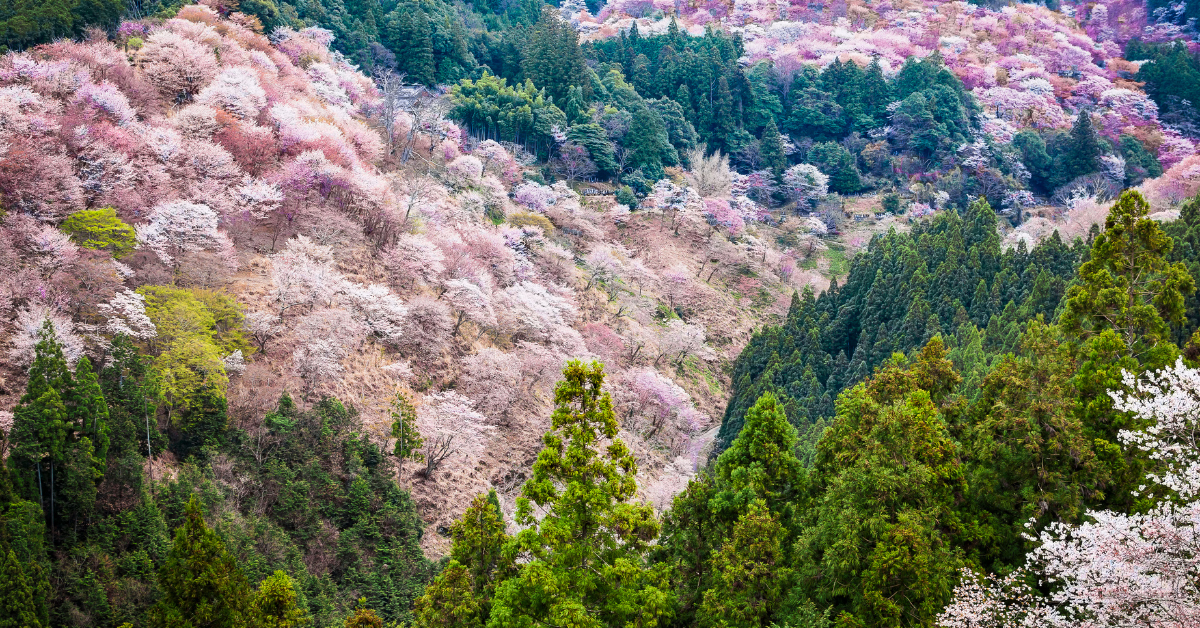Yoshinoyama in Nara Prefecture is not only famous for its cherry blossoms but also known as a sacred site of Shugendo with temples and shrines scattered across its mountains. Its mystical atmosphere and hidden pathways strongly evoke the world of Demon Slayer’s Swordsmith Village arc, making it a spiritual and cultural journey for fans and travelers alike.
What is Yoshinoyama
Yoshinoyama is a vast mountain area located in Yoshino District, Nara Prefecture. Since ancient times, it has been revered as a place of faith and ascetic practice, serving as the center of Shugendo. In 2004, it was inscribed as part of the UNESCO World Heritage Site “Sacred Sites and Pilgrimage Routes in the Kii Mountain Range,” symbolizing the spiritual core of Japanese culture.
The entire mountain is considered sacred ground, with steep paths and deep forests. Hidden temples and shrines appear along the way, enveloped in silence, exuding an atmosphere that truly recalls the “Swordsmith Village.” Behind its image as a tourist attraction lies profound history and spiritual devotion.
The Connection Between the Swordsmith Village and Yoshinoyama
In the Swordsmith Village arc of Demon Slayer, the story unfolds in a hidden village isolated from the outside world. The depth and seclusion of Yoshinoyama resonate with this setting.
Shugendo practitioners walking the mountain trails, enduring harsh training, resemble the Demon Slayer Corps honing their skills. Likewise, swordsmiths forging blades with fire and water align with rituals in Yoshinoyama such as waterfall purification and fire festivals.
Temples and Shrines Scattered Across Yoshinoyama
Yoshinoyama is home to numerous temples and shrines, each steeped in history and mysticism. They resonate strongly with the sacred atmosphere of the Swordsmith Village.
| Temple/Shrine | Features | Connection to Swordsmith Village |
|---|---|---|
| Kinpusenji Temple | Headquarters of Shugendo. Boasts Zaodo, one of Japan’s largest wooden structures | The guardian deity echoes the Hashira protecting the village |
| Yoshimizu Shrine | Associated with Minamoto no Yoshitsune and Emperor Go-Daigo | Its hidden history reflects the secrecy of the Swordsmith Village |
| Nyoirin-ji Temple | An imperial prayer temple of Emperor Go-Daigo | Loyalty and prayer resonate with the spirit imbued in swords |
| Katte Shrine | Ancient shrine for praying for bountiful harvests | Represents life-giving power, mirroring the symbolism of swords |
These sites are not merely tourist spots. They carry the weight of centuries of faith and tradition, offering visitors a sense of stepping into another world.
The Fantastical Cherry Blossoms of Yoshinoyama
Yoshinoyama is synonymous with cherry blossoms. Famed as “a thousand trees at a glance,” the sight of the mountain blanketed in blossoms is breathtaking.
| Season | Landscape of Yoshinoyama | Elements reminiscent of Swordsmith Village |
|---|---|---|
| Spring | Mountain covered in cherry blossoms | Falling petals resemble the trajectory of sword techniques |
| Summer | Lush greenery filling the mountains | Overflowing vitality recalls training grounds |
| Autumn | Fiery red foliage | Reflects the glowing heat of a forged sword |
| Winter | Silent snowbound scenery | Suggests a mystical barrier protecting the hidden village |
The cherry blossoms in spring, in particular, bring to mind the fantastical moments in Demon Slayer, giving visitors a profound sense of stepping into another world.
Seasonal Beauty of Yoshinoyama
Yoshinoyama reveals different faces throughout the year. Not only cherry blossoms but also lush summer greenery, autumn foliage, and winter snowscapes create illusions reminiscent of the Swordsmith Village.
| Season | Highlights | Connection to Demon Slayer |
|---|---|---|
| Spring | About 30,000 cherry trees | Evokes the fleeting yet powerful lives of the Demon Slayers |
| Summer | Verdant forests and waterfalls | Symbolic of Water Breathing |
| Autumn | Mountains dyed in crimson | Reminiscent of Flame Breathing |
| Winter | Quiet, snow-covered mountains | Mystical aura like a hidden barrier around the village |
The transformations of Yoshinoyama throughout the year mirror the variety of breathing styles in Demon Slayer, each offering layered beauty and meaning.
Yoshinoyama and the Culture of the Japanese Sword
The history of Yoshinoyama is closely tied to the culture of the Japanese sword. Mountain ascetics of old carried swords as symbols of protection and spiritual discipline. The sword was not merely a weapon, but a symbol of the soul and an object of devotion.
| Element | Meaning in Yoshinoyama | Connection to Swordsmith Village |
|---|---|---|
| Fire | Fire festivals of Shugendo | Resonates with the flames that forge swords |
| Water | Waterfall and river purification rituals | Evokes Water Breathing |
| Iron | Natural resources of the mountains | The lifeblood of swordsmithing |
The nature of Yoshinoyama and the rituals of Shugendo share the same spiritual essence that swordsmiths imbue into their blades.
Yoshinoyama as a Pilgrimage Site
For Demon Slayer fans, Yoshinoyama serves as a perfect pilgrimage destination.
- Offering prayers at Kinpusenji Temple may recall the Hashira repelling demons
- Standing at Yoshimizu Shrine evokes hidden determination preserved through history
- Walking along the cherry blossom-lined mountain paths mirrors the beauty of sword techniques
It provides not just sightseeing but an immersive experience that allows fans to relive the world of the series.
Conclusion
Yoshinoyama in Nara Prefecture resonates deeply with the Swordsmith Village arc of Demon Slayer. With its solemnity as a sacred site of Shugendo, the mysticism of its temples and shrines, and the beauty of its seasonal landscapes, it forms a stage where the world of the series can be felt in reality.
Visitors will not only enjoy its scenery but also reflect on the burdens, determination, and battles of the characters in the story. Yoshinoyama is both a tourist destination and a profound place of spiritual experience, leaving an indelible impression on the heart.






